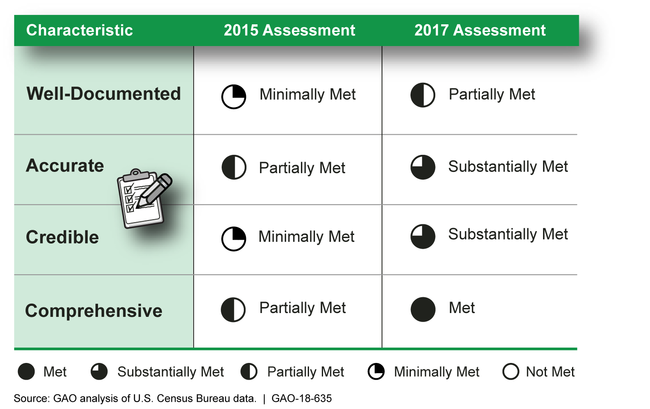2020 Census: Census Bureau Improved the Quality of Its Cost Estimation but Additional Steps Are Needed to Ensure Reliability
Fast Facts
In October 2017, the Census Bureau announced that the projected life-cycle cost of the 2020 Census had climbed to $15.6 billion, a 27-percent increase from its 2015 estimate.
A reliable cost estimate is essential to budgeting, planning, and managing the Census. We found that, while the Census Bureau has improved its cost-estimation process, the 2017 cost estimation still doesn’t meet all the necessary criteria of a reliable cost estimate. For example, the Bureau needs to improve documentation to support the cost estimate. We maintain our previous recommendation that the Census Bureau ensure that its cost estimate for the Census is reliable.
Increases to the 2020 Census Costs

Bar graph showing that the cost estimate for the Census increased by $3.3 billion between 2015 and 2017.
Highlights
What GAO Found
Since 2015, the Census Bureau (Bureau) has made significant progress in improving its ability to develop a reliable cost estimate. While improvements have been made, the Bureau's October 2017 cost estimate for the 2020 Census does not fully reflect all the characteristics of a reliable estimate. (See figure.) Specifically, for the characteristic of being well-documented, GAO found that some of the source data either did not support the information described in the cost estimate or was not in the files provided for two of its largest field operations. In GAO's assessment of the 2015 version of the 2020 Census cost estimate, GAO recommended that the Bureau take steps to ensure that each of the characteristics of a reliable cost estimate is met. The Bureau agreed and has taken steps, but has not fully implemented this recommendation.
Extent to Which Census Bureau Cost Estimate for 2020 Census Meets Standards for Reliability, 2015 vs. 2017

Source: GAO analysis of U.S. Census Bureau data | GAO 18-635
A reliable cost estimate serves as a tool for program development and oversight, helping management make informed decisions. During this review, GAO found the Bureau used the cost estimate to inform decision making.
Factors that contributed to cost fluctuations between the 2015 and 2017 cost estimates include:
Changes in assumptions. Among other changes, a decrease in the assumed rate for self-response from 63.5 percent in 2015 to 60.5 percent in 2017 increased the cost of collecting responses from nonresponding housing units.
Improved ability to anticipate and quantify risk. In general, contingency allocations designed to address the effects of potential risks increased overall from $1.3 billion in 2015 to $2.6 billion in 2017.
An overall increase in information technology (IT) costs. IT cost increases, totaling $1.59 billion, represented almost 50 percent of the total cost increase from 2015 to 2017.
Why GAO Did This Study
In October 2017, the Department of Commerce (Commerce) announced that the projected life-cycle cost of the 2020 Census had climbed to $15.6 billion, a more than $3 billion (27 percent) increase over its 2015 estimate. A high-quality, reliable cost estimate is a key tool for budgeting, planning, and managing the 2020 Census. Without this capability, the Bureau is at risk of experiencing program cost overruns, missed deadlines, and performance shortfalls.
GAO was asked to evaluate the reliability of the Bureau's life-cycle cost estimate. This report evaluates the reliability of the Bureau's revised life-cycle cost estimate for the 2020 Census and the extent to which the Bureau is using it as a management tool, and compares the 2015 and 2017 cost estimates to describe key drivers of cost growth. GAO reviewed documentary and testimonial evidence from Bureau officials responsible for developing the 2020 Census cost estimate and used its cost assessment guide (GAO-09-3SP) as criteria.
Recommendations
GAO is not making any new recommendations but maintains its earlier recommendation—that the Secretary of Commerce direct the Bureau to take specific steps to ensure its cost estimate meets the characteristics of a high-quality estimate. In its response to this report, Commerce generally agreed with the findings related to cost estimation improvements, but disagreed that the cost estimate was not reliable. However, until GAO's recommendation is fully implemented the cost estimate cannot be considered reliable.
